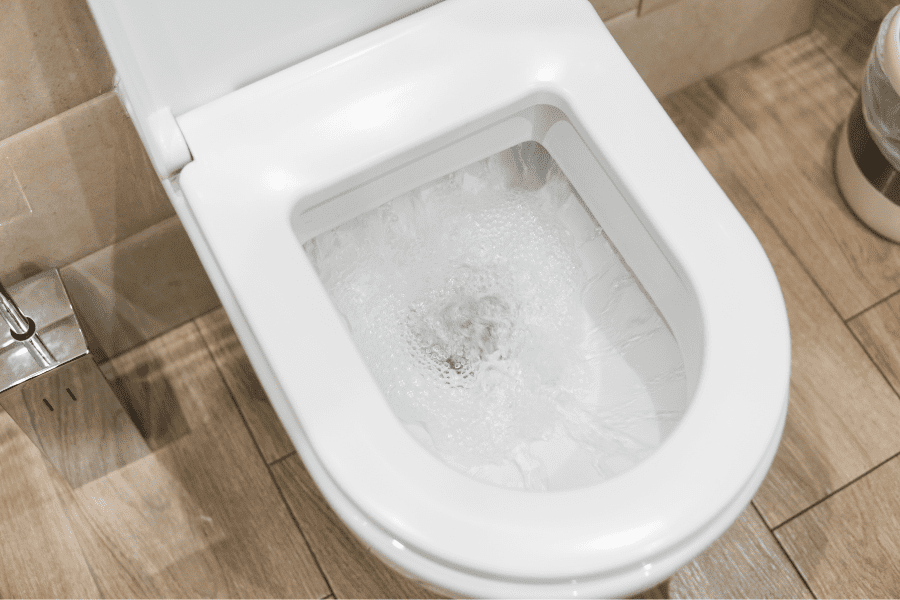If water keeps running into your toilet bowl long after you’ve flushed then you’ve come to the right place.
In this home self-help guide, we’ll look at all the common reasons why your toilet keeps running when flushed and how you might be able to fix it yourself.
What does it mean when your toilet keeps running?
It can be a huge inconvenience when your toilet stops flushing properly, particularly if you only have one toilet. Often, a a toilet that constantly runs after flushing means that key parts of toilet need adjusting, or replacing if damaged or worn.
These parts, such as the fill valve, flush mechanism and overflow pipe, control the flow of water in and out the toilet cistern. When these are damaged or incorrectly adjusted it can cause your water to constantly run into the toilet bowl.
Usually, when your toilet keeps running it’s down to three common reasons:
- Your fill valve requires adjustment
- The flush mechanism is leaking
- The overflow pipe requires adjustment
What might you need to repair a toilet that keeps running?
Before you start looking for the right solution, you may want to consider making sure you have the right tools and materials:
Tools
- Water pump pliers
- Screwdriver
- Towel, cloth, or sponge
Materials and parts
You may need these should they need replacing, don’t worry we’ll explain what they are:
- Flush mechanism
- Fill valve
How to fix a toilet that keeps running when you flush it
If you’re happy to do a bit of diagnostic work, you can take a look and see if you can resolve the problem yourself. Below are the potential reasons your toilet keeps running and how to fix them.
1) Your fill valve requires adjustment
Your toilet will only work properly when your cistern has the correct amount of water for it to fully flush. This level is normally marked on the inside of the cistern itself.
To check this you can lift the lid off the cistern and flush the toilet. Look to see if the water rises to the mark – if the water level does not rise back up to the mark your water level is too low.
How to fix it
To help more water to enter the cistern, try to adjust the arm on the float which is attached to the fill valve. The higher the float is, the more water will be let into the cistern. Allow for the water to rise to the water mark and try flushing.
If this doesn’t get your cistern to refill, then you could be looking at an issue with the water supply.
Firstly, you can check that the isolation valve on your supply pipe is fully open. To do this you’ll need a flat head screwdriver and check that the notch on the screw of the supply pipe is in line with the pipe.
Once you’ve tried this and it still doesn’t fix the problem, then if your toilet is supplied with water from a storage cistern, you may need to check the cold water storage cistern in the loft.
If your toilet is fed from a storage cistern
Your storage cistern could be what supplies cold water to the toilet, taps and shower etc. If your cold taps in the bathroom aren’t working, check the ball valve located in your storage cistern and gently move the arm up and down, as you did with your toilet cistern. You’ll know if it’s fixed the problem because you’ll hear your cistern starting to fill up. Remember to check that it shuts off after it has filled.
2) The flush mechanism is leaking
The flush mechanism is located at the bottom of your toilet cistern. It’s attached to your flush lever or button, which is the flush on the outside of your cistern.
This works as you flush the toilet, and lifts part of the mechanism which lets water into the toilet bowl.
How to fix it
You can try and resolve this issue by removing the lid off the cistern and switching off the water supply to your toilet using the isolation valve. Check that your flush lever or button is connected properly.
If the flush mechanism is damaged
When the toilet is flushed the flush mechanism allows water to flow into the toilet bowl. When it’s shut water is then able to fill up in the cistern.
How to fix it
With the water supply to the toilet switched off and the cistern lid removed, you can check the flush mechanism for damage.
If you notice that it’s damaged or worn then you’ll need a replacement, which you get from a DIY store or plumbers merchants. Once fitted, flush the toilet to check the issue is fixed.
3) The overflow pipe requires adjustment
The third cause could be that your overflow pipe is allowing water into the toilet bowl. This can happen when the overflow tube is set at the incorrect height. This will not be the case if your overflow runs externally from the cistern.
How to fix it
You can adjust the tube by pulling out the overflow tube from the overflow if it is telescopic or cutting it if it is too long.
When should I call in a plumbing professional?
If you find that none of these options work for you then you may find you require a plumber, in this case you can consider calling on our one-off repair service who will be able to assist you further.
You may also be interested in our plumbing and drainage cover which is designed to protect your home against plumbing emergencies with the minimum of fuss for a fixed monthly fee.
